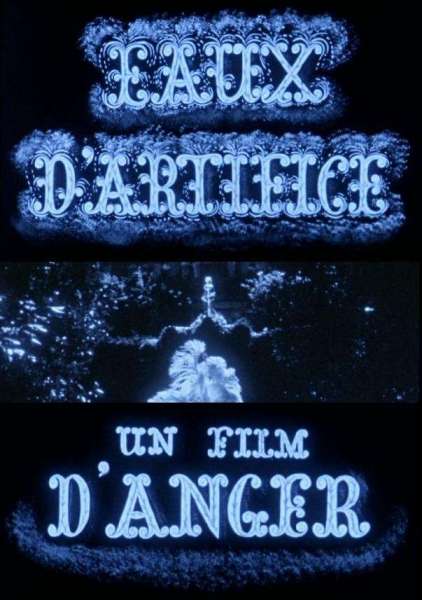Eaux d'artifice is a american film of genre Musical directed by Kenneth Anger released in USA on 1 january 1953
Eaux d'artifice (1953)

If you like this film, let us know!
Released in USA 1 january 1953
Length 12minutes
Directed by Kenneth Anger
OriginUSA
Genres Musical
Rating68%










Eaux d'artifice (1953) is a short experimental film by Kenneth Anger. The film was shot in the Villa d'Este in Tivoli, Italy. The film consists entirely of a woman dressed in eighteenth-century clothes who wanders amidst the garden fountains of the Villa d'Este ("a Hide and Seek in a night-time labyrinth") to the sounds of Vivaldi's "Four Seasons", until she steps into a fountain and momentarily disappears. The actress, Carmilla Salvatorelli (not "Carmello"), was "a little midget" Anger had met through Federico Fellini. Anger used a short actress to suggest a different sense of scale, whereby the monuments seemed bigger (a technique he said was inspired by etchings of the gardens in the Villa d'Este by Giovanni Battista Piranesi).
The title, a play on words, is meant to suggest Feux d'artifice (Fireworks), in obvious reference to Anger's earlier 1947 work. Film critic Scott MacDonald has suggested that Fireworks was a film about the repression of (the filmmaker's) gay sexuality in the United States, whereas Eaux d'Artifice "suggests an explosion of pleasure and freedom."
In 1993, this short film was selected for preservation in the United States National Film Registry by the Library of Congress as being "culturally, historically, or aesthetically significant".
Comments
Leave comment :
Suggestions of similar film to Eaux d'artifice
There are 6 films with the same director, 6355 with the same cinematographic genres, to have finally 70 suggestions of similar films.If you liked Eaux d'artifice, you will probably like those similar films :

Scorpio Rising (1969)
, 30minutesDirected by Kenneth Anger
Origin USA
Genres Fantasy, Musical
Themes Films about sexuality, Transport films, LGBT-related films, Road movies, LGBT-related films, LGBT-related film
Actors Bruce Byron
Rating67%





"Une vision transcendee du mythe du motard americain. La machine comme totem, du jouet a la terreur. Thanatos en chrome et cuir noir."
 , 38minutes
, 38minutesDirected by Kenneth Anger
Origin USA
Genres Fantasy, Horror
Actors Marjorie Cameron Parsons, Curtis Harrington, Kenneth Anger
Rating69%






Fireworks (1947)
, 14minutesDirected by Kenneth Anger
Origin USA
Genres Drama, Erotic, Fantasy, Horror
Themes Films about sexuality, LGBT-related films, LGBT-related films, LGBT-related film
Actors Kenneth Anger
Rating69%






The Girl Rush (1955)
, 1h25Directed by Robert Pirosh
Origin USA
Genres Comedy, Musical
Actors Rosalind Russell, Fernando Lamas, Eddie Albert, Gloria DeHaven, Marion Lorne, James Gleason
Rating51%





Gambling is second nature to Kim Halliday (Russell), whose father taught her all its ins and outs. Unfortunately, he also left her broke, living in Rhode Island and working as a receptionist in a museum run by her aunt Clara (Lorne).

School for Tramps (1955)
, 1h40Directed by Rogelio A. González
Genres Comedy, Musical, Romance
Actors Pedro Infante, Miroslava, Blanca de Castejón, Fernando Casanova, Dolores Camarillo, Rafael Estrada
Rating80%





In a mansion outside a nameless city (apparently Mexico City), lives the wealthy Valverde family: the patriarch Miguel (Oscar Pulido) a business man; Emilia (Blanca de Castejón), his wife, a fun and good-hearted but slightly deranged woman; and their two daughters: the oldest, Susi, short for Susana, (Miroslava Stern) and Lala, a nickname for Laura(Anabelle Gutierrez). Emilia often picks up tramps in hope to reform them into productive men, but they always disappear stealing anything they can in the house.

Devdas (1955)
, 2h39Directed by Bimal Roy
Origin Inde
Genres Drama, Musical, Romance
Themes Films about alcoholism, Medical-themed films, Films about music and musicians, Films about drugs, Films about sexuality, Erotic films, Films about prostitution, Musical films, Bollywood
Actors Dilip Kumar, Vyjayanthimala, Suchitra Sen, Motilal, Nazir Hussain, Iftekhar
Rating76%





Set against the backdrop of rural Bengal during feudal times, Devdas is a young man from a wealthy Bengali Brahmin family in India in the early 1900s. Paro alias Parvati is a young woman from a middle class Bengali Brahmin family, but belonging to a slightly lower status in terms of caste, affluence and status. The two families lived in a village, and Devdas and Paro were childhood friends.

The Court Jester (1955)
, 1h41Directed by Norman Panama, Bernard McEveety, Melvin Frank
Origin USA
Genres Comedy, Action, Adventure, Musical
Themes Musical films
Actors Danny Kaye, Glynis Johns, Basil Rathbone, Angela Lansbury, Cecil Parker, Mildred Natwick
Rating77%





Set in medieval England, the plot concerns the struggle to restore to the throne the rightful heir, a baby with a distinguishing birthmark, the purple pimpernel on his posterior. Danny Kaye plays Hubert Hawkins, an ex-carnival entertainer who becomes minstrel to the Black Fox, a Robin Hood-type character who leads a band of rebels in the forest in support of the true infant-king.
 Connection
Connection


